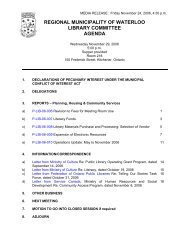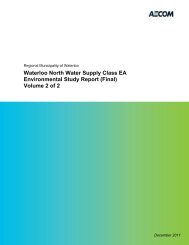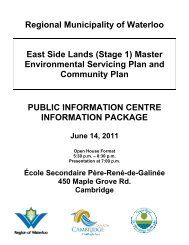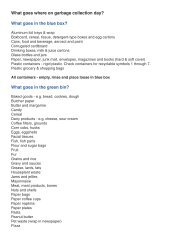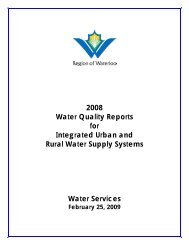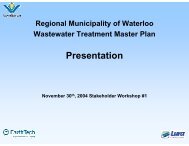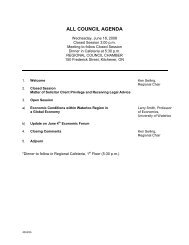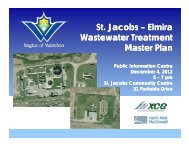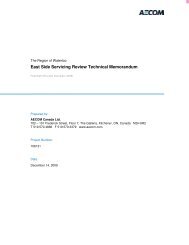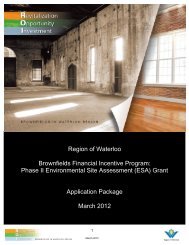Sam Ziemann From - Region of Waterloo
Sam Ziemann From - Region of Waterloo
Sam Ziemann From - Region of Waterloo
Create successful ePaper yourself
Turn your PDF publications into a flip-book with our unique Google optimized e-Paper software.
HYDROGEOLOGICAL ASSESSMENTSTRANGE STREET WATER SUPPLY CLASS EA UPDATEREGIONAL MUNICIPALITY OF WATERLOO5.0 ConclusionsBased on this update to the hydrogeologic assessment completed in the initial Class EA(Stantec, 2001), the following conclusions have been made:• The geologic conditions within the Strange Street Well Field and the <strong>Waterloo</strong> Moraine aresimilar to those previously described (Stantec, 2000), however, in light <strong>of</strong> recent detailedstudies (Bajc and Shirota, 2007; Stantec, 2009), updates to the hydrostratigraphicconceptual model have been made and presented within this report;• All <strong>of</strong> the current Production Wells (K10A, K11A, K13, K18, and K19) are interpreted to bescreened within Aquifer 1 (AFB2). This layer typically ranges in thickness from 0 to 40 m,with an average thickness <strong>of</strong> about 10 m, and is typically not present below an elevation <strong>of</strong>310 m AMSL. It is predominantly defined by fine and medium sand, silt, and gravel basedon continuous core logging data;• Groundwater within the supply aquifer is generally <strong>of</strong> good quality with the exception <strong>of</strong>elevated chloride and sodium in some wells on the eastern end <strong>of</strong> the well field, andelevated iron and manganese as a result <strong>of</strong> the natural aquifer characteristics;• A recent evaluation <strong>of</strong> well performance was completed throughout the well field, and it wasnoted that Production Well K13 had experienced a significant decrease in performancecompared to the as-constructed well capabilities. Production Well K18 still performs near itsas-constructed capacity, and recent work completed on Production Wells K10A and K19have improved performance to within an acceptable level in comparison to as-constructeddetails. It is recommended that Production Well K15 be abandoned;• In order to secure the water supply from the Strange Street Well Field, additional test drillinglocations were proposed near K11A/K13, in the Westmount Golf and Country Club practicearea, and within Gzowski Park (Figure 1). Selection <strong>of</strong> each location was based on athorough review <strong>of</strong> the area geology and stratigraphy, water quality, ease <strong>of</strong> site access, andease <strong>of</strong> connection to the existing water supply system;• Test Well K-SS-TW1-11, was constructed at Gzowski Park. Construction <strong>of</strong> a test well atthe Westmount Golf and Country Club was not completed due to issues with site access;• Aquifer 1 (AFB1 and AFB2) was interpreted to be approximately 29 m thick based oncontinuous core samples collected at K-SS-OW1A-11. The middle Maryhill Till (ATB2) wasnot observed at K-SS-OW1A-11 despite being present at Monitoring Well K-SS13-99 whichis located about 250 m east <strong>of</strong> K-SS-OW1-11;• Aquifer 1 hydraulic parameters were estimated using the observed drawdown atK-SS-OW1B-11 and K-SS-OW1C-11 during the performance testing at K-SS-TW1-11. Ahls v:\01609\active\161110897_strange_st\planning\report\final hydrogeo assessment\final\fnl_rpt_120319.docx 5.1



